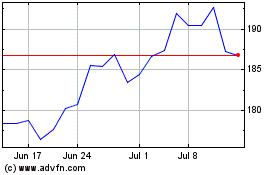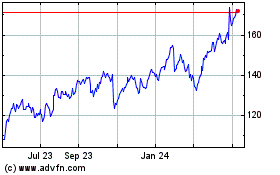The Obama administration said companies developing driverless
cars should adopt a series of government recommendations to certify
their vehicles are ready for U.S. roads, a policy aimed at
front-running possible conflicting local rules and potentially
reducing traffic fatalities.
The U.S. Transportation Department, in guidelines to be rolled
out Tuesday, urges that car makers and other developers submit to a
15-point "safety assessment" outlining how driverless cars are
tested, safeguards should systems fail and how vehicles are
programmed to comply with existing traffic laws. The guidelines
also expect companies to detail plans to prevent vehicle
hacking.
The policy amounts to suggestions as opposed to firm regulations
with legal force. Federal highway safety regulators have resisted
developing official rules for driverless cars amid concerns the
yearslong process could result in rules rendered moot by
fast-emerging technologies.
Instead, U.S. officials are hoping to spur companies to share
data on crashes, detail their latest systems to regulators and take
steps to ensure technologies are traffic-ready. Current regulations
set out specific safety standards for seat belts, brakes and other
traditional systems envisioning human drivers. The latest
autonomous-vehicle guidelines largely lack specific benchmarks and
delineate areas for companies to share and submit information.
The guidelines apply to fully driverless cars that don't yet
predominate U.S. roads, though portions of the suggestions affect
vehicles with semiautonomous features that assist drivers. The
suggestions could change depending on the outcome of November's
presidential election.
Auto makers and technology companies have been concerned about
conflicting rules in different states. California, for instance,
previously proposed requiring drivers obtain special licenses for
autonomous cars and subjecting them to specific tests.
The U.S. guidelines suggest states retain prominence over
driver's licenses, car registrations, traffic laws, insurance and
legal liabilities. But they say states should steer clear of
conflicting safety standards for driverless cars, leaving that
oversight to federal officials. Officials said they would consider
exempting companies from existing rules for emerging technologies
deemed to have promising safety benefits.
"This is a change of culture for us," said Transportation
Secretary Anthony Foxx on a call with reporters Monday, noting
officials typically make cars meet specific standards. "It isn't
prescriptive in the sense that we're saying there have to be
certain proof points. We have to have a level of confidence. It's
really creating a more open-ended type of approach."
Regulators will investigate and urge recalls when systems pose
unreasonable risks to safety, officials said.
The National Highway Traffic Safety Administration is probing
the May fatal crash of a Tesla Motors Inc. electric car driving
itself with its Autopilot system. Officials want the ability to
clear such systems before they hit the market and require companies
to immediately address technologies deemed "imminent hazards," but
that authority would require congressional approval. They also want
to ensure vehicles eventually can talk to each other to help avoid
crashes.
"Guidance is the right action to take since the technology is
developing quickly and collaboration between auto makers and
[regulators] is critical to avoid policies that become outdated,"
said a spokeswoman for the Alliance of Automobile Manufacturers, a
Washington advocacy group representing a dozen car makers. "We look
forward to working with [regulators] and state policy makers to
produce a consistent, nationwide approach that ensures these
vehicles are brought to market without unnecessary restrictions or
delay."
The development of driverless cars has sparked a technological
arms race among traditional car manufacturers, technology titans
and Silicon Valley startups. But hurdles with infrastructure,
regulations, and clarity on legal liability could slow down
adoption.
U.S. officials are attempting to balance encouraging adoption of
promising technologies that researchers contend will cut traffic
fatalities while ensuring they're safe. Traffic deaths topped
35,000 in 2015, according to government figures, largely because of
human error.
The challenge was thrown into sharp relief after the May fatal
crash of the Tesla car. Tesla said the car's automatic emergency
braking system failed to detect the white trailer on a truck that
pulled in front of the car against a brightly-lit sky, leading to a
collision.
Tesla plans before the end of this month to introduce updated
Autopilot software that relies more on radar signals and safeguards
to keep drivers engaged, changes Chief Executive Elon Musk said
would have prevented the May fatal crash.
"We believe we've struck the right balance between safety and
innovation and shown how those two things can work with each other
and not at cross-purposes," Mr. Foxx said.
Motorists have expressed enthusiasm for automated-driving
technologies such as adaptive cruise control, automatic brakes and
lane-keeping assists. But they've also conceded placing outsize
confidence in the features despite fine print and other warnings.
Daimler AG's Mercedes-Benz in July pulled a television ad amid
concerns it portrayed a car as fully self-driving rather than one
with a suite of technologies that perform some driving functions
under certain circumstances.
Driverless cars are already being tested, with ride-sharing firm
Uber Technologies Inc. putting some on Pittsburgh roads earlier
this month. General Motors Co. and Uber rival Lyft Inc. have
discussed plans to eventually test a fleet of self-driving
Chevrolet Bolt electric taxis.
"Automated vehicles are no longer science fiction. In fact,
they're here," said Jeffrey Zients, a top adviser to the president
and director of the National Economic Council.
Industry experts expect autonomous vehicles to dot roads in
cities as part of ride-sharing efforts in the near term. Lyft
co-founder and president John Zimmer expects car ownership will all
but end in major U.S. cities in less than a decade. Uber is close
to opening an office in Detroit to collaborate with conventional
car makers, an executive said Monday.
Car companies and technology firms are taking varied approaches
to autonomous driving. Google parent Alphabet Inc. is testing
driverless cars that don't require human interaction, viewing such
vehicles as potentially safer than those with stepping-stone
technologies. Others including Tesla are continuing to roll out
features that can let cars drive themselves in certain conditions
but don't render them fully autonomous.
John D. Stoll contributed to this article.
Write to Mike Spector at mike.spector@wsj.com
(END) Dow Jones Newswires
September 19, 2016 21:45 ET (01:45 GMT)
Copyright (c) 2016 Dow Jones & Company, Inc.
Alphabet (NASDAQ:GOOG)
Historical Stock Chart
From Mar 2024 to Apr 2024

Alphabet (NASDAQ:GOOG)
Historical Stock Chart
From Apr 2023 to Apr 2024
